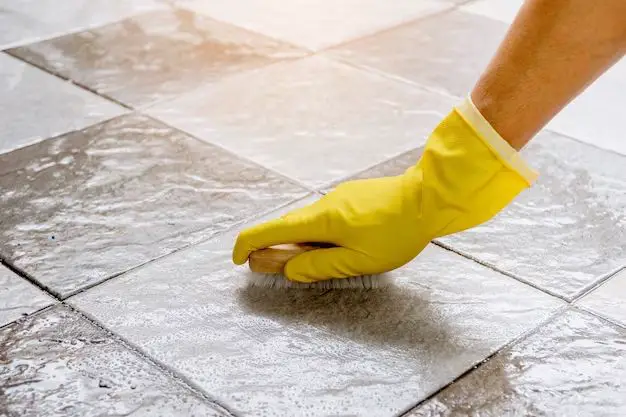Cleaning tile floors that look like wood requires some special considerations to avoid damaging the faux wood finish. Proper cleaning helps maintain the appearance of the tiles and prevents buildup of dirt, grime, and bacteria.
Page Contents
Assess the Flooring
The first step is to assess the type of tile flooring. There are a few main options for faux wood tile:
- Porcelain tile – Made from clay and fired at high temperatures, these are very durable and low maintenance.
- Ceramic tile – Also clay-based but fired at lower temperatures than porcelain. Can be more prone to wear and scratches.
- Vinyl tile – Made from resilient vinyl material printed with wood-look designs. Scrubbable but can scratch or stain.
Understanding your specific tile material will determine the proper cleaning techniques and products to use.
Regular Maintenance
For routine cleaning, there are a few basic steps to safely clean faux wood tile floors:
- Sweep or vacuum – Remove any loose debris or dirt.
- Damp mop – Use a lightly dampened mop to wipe up surface dust and stains. Avoid excessive moisture.
- pH-neutral cleaner – When needed, mix a pH-neutral, wood-safe cleaner into the mop water. Check the product label.
- Dry and buff – Wring mop thoroughly and go over the floors again to remove residue and restore shine.
You want to avoid soaking or flooding the tile, which can cause warping and damage. Stick to damp mopping only.
Deep Cleaning
For a more thorough periodic cleaning, use these steps:
- Sweep and vacuum – Remove all surface debris, dirt, and dust.
- Wet mop – Dampen mop with warm water and a small amount of pH-neutral cleaner. Let stand briefly to allow cleaner to work.
- Scrub – Use a stiff scrub brush and scrub tiles vigorously to remove built-up grime and stains. Focus on high traffic areas.
- Rinse – Wipe and rinse tiles thoroughly with a clean, damp mop to remove all cleaner residue.
- Absorb and dry – Use towels to absorb any excess water. Let air dry completely.
- Reseal grout – Apply grout sealer to grout lines if needed to protect from stains.
Take care not to over-wet the tile when scrubbing. Work in sections and fully dry before moving on.
Problem Spot Cleaning
For cleaning tough stains or dirt buildup, use these techniques:
- Grease/oil stains – Mix warm water and dish soap or degreasing cleaner. Scrub with a stiff brush and rinse thoroughly.
- Wax/sealant buildup – Use a wax stripper formulated for tile floors. Follow product instructions carefully.
- Hard water deposits – Mix equal parts warm water and vinegar. Mop onto affected areas and let sit briefly before rinsing.
- Mold/mildew – Use an antimicrobial cleaner or diluted bleach solution. Never mix bleach and vinegar.
You can use a soft nylon scrub pad or magic eraser sponge for extra scrubbing power on tough spots.
Cleaning Products to Avoid
Some all-purpose cleaners and products can actually damage faux wood tile floors. Avoid using:
- Vinegar – Full strength vinegar can etch and discolor grout
- Ammonia – Can dull or scratch floors
- Abrasive cleaners – Can scratch softer vinyl tiles
- Acidic cleaners – Can etch and discolor grout and tile
- Steam mops – Heat and moisture can damage floors
Always check that a cleaner is safe for use on wood, ceramic, and vinyl floors before using.
Cleaning and Maintenance Tips
Follow these tips to keep faux wood floors looking their best:
- Place mats at entrances to trap dirt, grit, and moisture from shoes.
- Immediately wipe up spills and water to avoid damage.
- Use felt pads under furniture legs to prevent scratches.
- Reseal grout lines annually to protect from stains.
- Sweep and mop at least once a week for light traffic areas.
- Avoid walking on floors with cleats, stilettos, or sharp objects.
- Rearrange rugs periodically to minimize uneven fading and wear.
When to Call a Pro
For deep cleaning extremely dirty floors, restoring badly scratched/worn floors, or repairing damage like chips or cracks, it’s best to hire a professional floor cleaning and refinishing company.
Professionals have commercial equipment and chemical cleaners that can deep clean and refinish floors without harm. They can also spot repair minor damage and re-coat floors to look like new.
Conclusion
Faux wood tile floors add beautiful, natural-looking wood grain patterns with the durability and water resistance of tile. By using proper cleaning techniques and avoiding excess moisture, you can safely clean and maintain the appearance of wood-look tile floors.
Follow the right process with pH-neutral cleaners to prevent damaging the tile or stripping the finish. Periodic deep cleaning and prompt spot treatment of spills or stains also helps keep floors looking like real hardwood.
With regular care and by avoiding abrasives or harsh chemicals, you can enjoy the beauty of faux wood tile floors for years to come.
